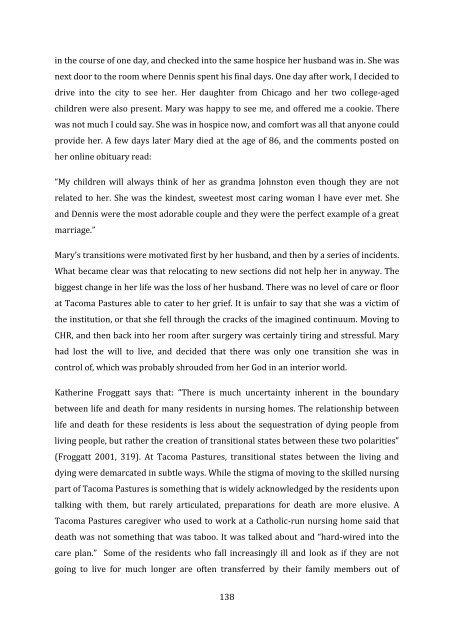Philip Y. Kao PhD thesis - Research@StAndrews:FullText
Philip Y. Kao PhD thesis - Research@StAndrews:FullText
Philip Y. Kao PhD thesis - Research@StAndrews:FullText
You also want an ePaper? Increase the reach of your titles
YUMPU automatically turns print PDFs into web optimized ePapers that Google loves.
in the course of one day, and checked into the same hospice her husband was in. She was<br />
next door to the room where Dennis spent his final days. One day after work, I decided to<br />
drive into the city to see her. Her daughter from Chicago and her two college-aged<br />
children were also present. Mary was happy to see me, and offered me a cookie. There<br />
was not much I could say. She was in hospice now, and comfort was all that anyone could<br />
provide her. A few days later Mary died at the age of 86, and the comments posted on<br />
her online obituary read:<br />
“My children will always think of her as grandma Johnston even though they are not<br />
related to her. She was the kindest, sweetest most caring woman I have ever met. She<br />
and Dennis were the most adorable couple and they were the perfect example of a great<br />
marriage.”<br />
Mary’s transitions were motivated first by her husband, and then by a series of incidents.<br />
What became clear was that relocating to new sections did not help her in anyway. The<br />
biggest change in her life was the loss of her husband. There was no level of care or floor<br />
at Tacoma Pastures able to cater to her grief. It is unfair to say that she was a victim of<br />
the institution, or that she fell through the cracks of the imagined continuum. Moving to<br />
CHR, and then back into her room after surgery was certainly tiring and stressful. Mary<br />
had lost the will to live, and decided that there was only one transition she was in<br />
control of, which was probably shrouded from her God in an interior world.<br />
Katherine Froggatt says that: “There is much uncertainty inherent in the boundary<br />
between life and death for many residents in nursing homes. The relationship between<br />
life and death for these residents is less about the sequestration of dying people from<br />
living people, but rather the creation of transitional states between these two polarities”<br />
(Froggatt 2001, 319). At Tacoma Pastures, transitional states between the living and<br />
dying were demarcated in subtle ways. While the stigma of moving to the skilled nursing<br />
part of Tacoma Pastures is something that is widely acknowledged by the residents upon<br />
talking with them, but rarely articulated, preparations for death are more elusive. A<br />
Tacoma Pastures caregiver who used to work at a Catholic-run nursing home said that<br />
death was not something that was taboo. It was talked about and “hard-wired into the<br />
care plan.” Some of the residents who fall increasingly ill and look as if they are not<br />
going to live for much longer are often transferred by their family members out of<br />
138
















